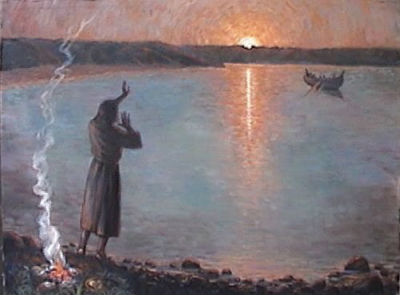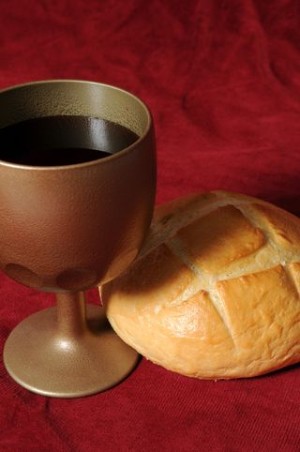Communion – It’s a Beautiful Word
By Neil Earle
 Jesus said to them, “Come and have breakfast.” (John 21:12)
Jesus said to them, “Come and have breakfast.” (John 21:12)It’s a wonderful word “Communion.”
It conjures up “community,” “communication,” “conviviality, “comity,” etc. Older churches such as the Anglican and Catholic have been using it for centuries. Ultimately its roots lie far back to the Middle East where fellowship and friendship meals are still important.
The Bible traces this consistently: Abram enjoying a supper in the Plain of Mamre with the Lord God Himself (Genesis 18), Jacob and Laban cementing a future relationship over food (Genesis 31:46), and – most astonishingly – Moses and the elders eating with God on Mount Sinai for 40 days (Exodus 24:7). Jesus himself used friendship meals and banquets to powerful effect in communicating more about God to his human meal-partners (Luke 19:1-10).
The New Testament churches commonly use the word “Eucharist” for communion and that word derives from the Greek “eucharisteas” or “thanksgiving” from Luke 22:19 when Jesus “gave thanks” at his Last Supper. The service commemorates our participation in a deep-seated relationship with God and Jesus Christ through the Presence of the Holy Spirit. Paul gives warrant for this in 1 Corinthians 10:16, “Is not the cup of thanksgiving for which we give thanks a participation in the blood of Christ? And is not the bread that we break a participation in the body of Christ?”
I grew up calling it Holy Communion but there are other Biblical terms such as “the Lord’s Supper,” “the breaking of the bread,” “the table of the Lord.”
But why do Christians do it so often?
 Jurgen Moltmann, author of Theology of Hope, came to see God in a prison of war camp.
Jurgen Moltmann, author of Theology of Hope, came to see God in a prison of war camp.When God Became Man
The German theologian Jurgen Moltmann came to see God in a prisoner of war camp after World War Two with most of his childhood friends killed. Through a spiritual experience he came to understand the earthly Jesus, “the One who brings God’s kingdom to the poor, heals the sick, accepts the despised, calls people to discipleship, and wins for us a life with his hopes and his tasks.”
He wrote in Theology of Hope in 1964: “The Gospels tell us about the sufferings and death of Christ. The self-giving of God’s son for the reconciliation of the world is communicated to us in the Eucharist in the form of bread and wine.” His body is made life for us (John 6:53-54) and that bubbling life inside us impels and empowers us to struggle against the forces of death and despair, knowing the final victory is sure.
The world’s suffering reminded Moltmann of the human Jesus – the man who was God and even more the God who became man. Seeing Bread and Wine laid out in church recalls that Jesus became flesh to identify with our suffering. And seeing the bread and wine laid out before us can remind us and the world of Jesus’ astonishing claims. In John 6 we see Jesus confronting his home town folks in a strong argument revolving around him explaining his real identity, that his origins were indeed from heaven, that he was, in effect, the Bread of Life. “Your forefathers ate the manna in the wilderness yet they died,” Jesus testified, “But here is the Bread that comes down from heaven, which a man may eat and not die. I am the living Bread that came down from heaven. If anyone eats of this Bread he will live forever. This Bread is my flesh which I will give for the light of the world” (John 6:50-51).
Wow!
As various Christian writers have observed, no sane man ever spoke the way Jesus Christ talked. Muhammed did not claim to be the Bread of life. The Buddha didn’t talk that way. Confucius didn’t even allude to such things. But Jesus did. He even took it further: “Just as the living Father sent me and I live by the Father, so the one who feeds on me will live because of me” (verse 57).
Most of Jesus’ so-called disciples walked out on him at that moment. Only the Twelve remained. Perhaps we’d have left too, not knowing the rest of the story. You know – the resurrection, empty tomb, ascension, and all that. But seeing bread and wine placed before them on a table quite regularly reminds Christians of the actual physical presence of Jesus on this earth – Son of Man as well as Son of God, walking and teaching near the Sea of Galilee, of his being offered up to brutal death in Jerusalem.
But it brings to mind something else as well, as the great theologian John Calvin reminds us:
“The Lord intended by calling Himself the Bread of Life to teach not only that salvation for us rests in His death and resurrection but also that by true partaking of Him, His life passes into us and is made ours.”
The undefeated yet humble Messiah is the rugged, conquering spiritual life inside us that enables Christians to meet the challenges he lays down for us. “Without me you can do nothing,” Jesus taught.

A Source of Strength
Secondly, taking Jesus symbolically inside our spiritual self is our source of nourishment for all true spiritual growth and progress. Biblically speaking, bread strengthens men’s heart; it’s usually bread you miss most when you go on a diet (Psalms 104:15). With the true Bread to draw upon for strength and nourishment we can “grow up” to Christ’s example, just as well-fed children grow before their parents (Ephesians 3:19). “Maturity” is a state Christians are challenged to grow into and there are so many examples of that in Scripture and around us today.
Romans 5:10 hit home as well: “We shall be saved by his life.”
His body is made life for us (John 6:53-54) and it is a conquering enduring life, the Life of the One who walked through death and suffering triumphantly and out the other side in a resurrection that is still the most controversial thing about him and his message. That eternal life bubbling up inside us gives us the power to endure the shocks and hazards of this life and impels and empowers us to struggle against the forces of death and despair, knowing the final victory is sure.
Experiencing the Presence
A third reason for taking Communion at this and any time of year lies in the very real experience Christians have of dwelling more fully in the embrace of the Loving Triune God. Habakkuk, one of the prophet’s names meant, very roughly, “love’s embrace” and Jesus was the ultimate fulfillment of that prophetic name.
When the apostle Paul was near a terrifying shipwreck on the Mediterranean Sea, he experienced a dream/vision from the Lord saying all would be well. Paul “took some bread and gave thanks to God in front of them all. Then he broke it and began to eat. They were all encouraged and ate some food themselves” (Acts 27:35-36).
Paul thus showed that the Christian hope of eternal salvation (already at work within them) and even physical deliverances were very clearly linked. The crew followed his example and took the bread and listened to his prayer of thanks – a very strange Eucharist. This showed we could do communion anywhere at any time and that Jesus was near even in a howling windstorm with a boat about to be shattered upon the rocks. Astronaut Buzz Aldrin even took communion on the moon! Unusual things happen sometimes when the church gathers to break the bread and drink the wine. There is a deeper sense of God’s strengthening presence.
Some years back our church gathered for a Jewish-style reenactment of Communion. One young man wanted to take a piece of the hard Jewish bread – matzo – we were using. But he had suffered a violent sore throat all week. “Should he take it?” he asked himself. When he heard the pastor remark that “people have been healed right at the Eucharist” he took courage and ate. He felt fine and has not suffered sore throat to this day. Coincidence? An accident? Perhaps, but don't try telling that to this parishioner.
Bible teacher John Calvin said it very well: “Even though it seems unbelievable that Christ’s flesh, separated from us by so great distance, penetrates to us so that it becomes our food,” he wrote, “let us remember how far the secret power of the Holy Spirit towers above our senses, and how foolish it is to measure Him by our measure.”
The church takes comfort in Jesus’ parting words, “I am with you always, even to the end of the world.” One way the presence of Christ is experienced among us is through the regular reaffirmation in the Communion service.
The Strangest Meal
In the marvelous plan of God for his people, Jesus new we needed physical reminders of what he was doing among us. Communion bread and wine is linked to salvation, to strength for the journey, to experiencing Jesus more fully, and sometime to physical deliverance. As that famous painting showed, Jesus started the formal gathering of the saints around bread and wine the night before he died and the early Church got the point. They met together often to break bread and be spiritually renewed (Acts 2:42). Altogether Luke record ten key teachings tied in to the eating in his presence. But there is something else as well. The mystical meaning of the Communion intrudes itself.
In the breaking of bread at Bethsaida, the disciples collect twelve baskets of overflow food after the miracle of the loaves and pickled sardines (Luke 9:10-17). These baskets signify their part in the Great Harvest of souls Jesus would make possible after his resurrection tough the power of the Holy Spirit at work among the disciples. And it is after his resurrection that Jesus ate and drank with his disciples after coming back from the dead (Luke 24:41; John 21:12).
Can you believe it?
Here was a divine personage, a resurrected man, eating among them. John 21 tells that astonishing report. At the Last Supper Jesus linked the breaking of bread and drinking wine with life in the Kingdom of God (Matthew 26:29). But now here it is being carried out during the “interregnum” between Jesus coming back from the dead and his final return to heaven.
The Wonder of It All
By this strange occurrence on the Sea of Galilee, at a very definite spot on this small planet, the Bible writers intend to signal to us the mystical meaning of the Communion. Participation in the Eucharist has the potential to draw us closer than almost anything else to the wonder of the life beyond. When two disciples on the Emmaus Road experienced Jesus in the breaking of the bread they immediately bolted back to Jerusalem to tell the other disciples they had been with the risen Lord, had eaten a meal with him (Luke 24:28-35).
Jesus used the eating of food both to emphasize his tangible resurrected presence and to underscore that he was no mere apparition. How strange that men should eat and drink with a man back from the dead! That is, unless…unless he was indeed the God-man, the risen Lord as he said.
And thus the Communion service has the potential to project us into the Kingdom of Heaven already. How? Here is John Calvin again:
“Paul graced that intimate fellowship in which we are joined with his flesh when he said, ‘we are members of his body, of his bones, of his flesh’ (Ephesians 5:30). To witness to this thing greater than all words, the Apostle ends his discourse with an exclamation, ‘This is a great mystery’ (Ephesians 5:32).
Paul preferred to marvel at all of this rather than over-explain it. So should we. Enough happens during Communion sometimes to make us all exclaim “My Lord and my God.” Have you taken communion lately?